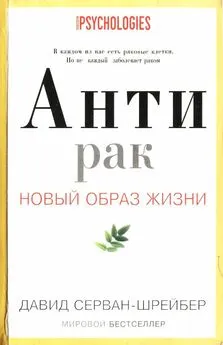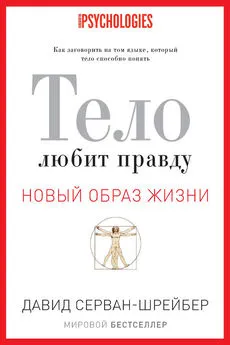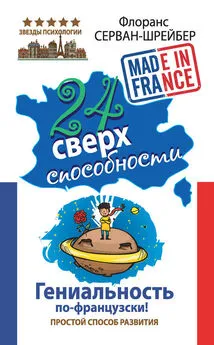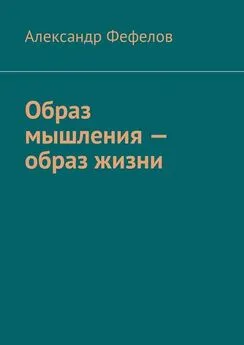Давид Серван-Шрейбер - Антирак. Новый образ жизни
- Название:Антирак. Новый образ жизни
- Автор:
- Жанр:
- Издательство:РИПОЛ классик
- Год:2010
- Город:Москва
- ISBN:978-5-386-02111-5
- Рейтинг:
- Избранное:Добавить в избранное
-
Отзывы:
-
Ваша оценка:
Давид Серван-Шрейбер - Антирак. Новый образ жизни краткое содержание
Антирак. Новый образ жизни - читать онлайн бесплатно ознакомительный отрывок
Интервал:
Закладка:
43. McMillan-Price, J., et al., “Comparison of 4 Diets of Varying Glycemic Load on Weight Loss and Cardiovascular Risk Reduction in Overweight and Obese Young Adults: A Randomized Controlled Trial,” Archives of Internal Medicine 166, no. 14 (2006): 1466-75.
44. Collectif LaNutrition.fr., Le Régime IG Minceur: comment perdre du poids en maîtrisant son sucre sanguin (Vergèze, France: Thierry Souccar Editions, 2007).
45. Heini, A. F., and R. L. Weinsier, “Divergent Trends in Obesity and Fat Intake Patterns: The American Paradox,” American Journal of Medicine 102, no. 3 (1997): 259-64.
46. Willett, W.C., “Dierary Fat Plays a Major Role in Obesity: No,” Obesity Reviews 3, no. 2 (2002): 59-68.
47. Weill, P., Tous Gros Demain? (Paris, France: Plon, 2007).
48. Ibid.
49. Ailhaud, G., and P. Guesnet, “Fatty Acid Composition of Fats Is an Early Determinant of Childhood Obesity: A Short Review and an Opinion,” Obesity Reviews 5, no. 1 (2004): 21-26.
50. Ailhaud, G., F. Massiera, P. Weill, et al., “Temporal Changes in Dietary Fats: Role of n-6 Polyunsaturated Fatty Acids in Excessive Adipose Tissue Development and Relationship to Obesity,” Progress in Lipid Research 45, no. 3 (2006): 203-36.
51. Weill, P., B. Schmitt, G. Chesneau, et al., “Effects of Introducing Linseed in Livestock Diet on Blood Fatty Acid Composition of Consumers of Animal Products,” Annals of Nutrition & Metabolism 46, no. 5 (2002): 182-91.
52. Ailhaud and Guesnet, “Fatty Acid Composition of Fats Is an Early Determinant of Childhood Obesity.”
53. Simopoulos, A. P., “The Importance of the Ratio of Omega-6/Omega-3 Essential Fatty Acids,” Biomedicine Pharmacotherapy 56, no. 8 (2002): 365-79.
54. Simopoulos, A. P., and N. Salem, “Omega-3 Fatty Acids in Eggs from Range-Fed Greek Chickens,” New England Journal of Medicine 321, no. 20 (1989): 1412.
55. Ip, C., J. A. Scimeca, and H. J. Thompson, “Conjugated Linoleic Acid: A Powerful Anticarcinogen from Animal Fat Sources,” Cancer 74, 3 supp. (1994): 1050-54.
56. Lavillonniere, F., V. Chajes, J-C. Martin, et al., “Dietary Purified cis-9, trans-11 Conjugated Linoleic Acid Isomer Has Anticarcinogenic Properties in Chemically Induced Mammary Tumors in Rats,” Nutrition and Cancer 45, no. 2 (2003): 190-94.
57. Bougnoux, P., A. Barascu, M.-L. Jourdain, et al., “Acide Linoléique Conjugué et Cancer du Sein,” Oléagineux, Corps Gras, Lipides 2005; 12(1): 56-60.
58. Dubnov, G., and E. M. Berry, “Omega-6/Omega-3 Fatty Acid Ratio: The Israeli Paradox,” World Review of Nutrition & Dietetics 92 (2003): 81-91.
59. Weill, Tous Gros Demain?
60. van Kreijl, C., Knaap, A., Busch, M., et al. “Ons eten gemeten. Gezonde voeding en veilig voedsel in Nederland.” Amsterdam NL: Public Health Department of the Netherlands; 2004. Report No.: RIVM report 27055509, available at Bohn, Stafleu, Van Loghum.
61. Nationaal Kompas Volksgezondheid. “Verkeersongevallen. Omvang van het probleem. Verkeersongevallen naar leeftijd en geslacht, 2003-2007”: Public Health Department, Netherlands, 2004.
62. Chajes, V., et al., “Serum Trans-Monounsaturated Fatty Acids Are Associated with an Increased Risk of Breast Cancer in the E3N-EPIC Study,” American Journal of Epidemiology (2008). DOI: 10.1093/aje/kwn069.
63. Hibbeln, J., W. Lands, and E. Lamoreaux, “Quantitative Changes in the Availability of Fats in the US Food Supply,” 5th Congress of the International Society for Study of Fatty Acids and Lipids, May 7-11, 2002 Montreal, Canada, 2002, p. 10.
64. Bougnoux, P., et al., “ Alpha-Linolenic Acid Content of Adipose Breast Tissue: A Host Determinant of the Risk of Early Metastasis in Breast Cancer,” British Journal of Cancer 70, no. 2 (1994): 330-34.
65. Maillard, V., P. Bougnoux, P. Ferrari, et al., “N-3 and N-6 Fatty Acids in Breast Adipose Tissue and Relative Risk of Breast Cancer in a Case-Control Study in Tours, France,” International Journal of Cancer 98, no. 1 (2002): 78-83.
66. Pollan, M., “Power Steer,” New York Times Magazine , March 31, 2002.
67. Pollan, M., “Unhappy Meals,” New York Times Magazine , January 28, 2007.
68. Pollan, M., The Omnivore’s Dilemma (New York: Penguin Press, 2006).
69. Cunnane, S., and L. U. Thomson, F laxseed in Human Nutrition (Champaign, IL: AOCS Press, 1995).
70. Weill, Schmitt, Chesneau, et al., “Effects of Introducing Linseed in Livestock Diet on Blood Fatty Acid Composition of Consumers of Animal Products.”
71. Weill, Tous Gros Demain?
72. Ailhaud, Massiera, Weill, et al., “Temporal Changes in Dietary Fats.”
73. World Cancer Research Fund, Food, Nutrition and the Prevention of Cancer: A Global Perspective (London: World Cancer Research Fund and American Institute for Research on Cancer, 2007).
74. Pollan, “Unhappy Meals.”
75. Pollan, The Omnivore’s Dilemma.
76. Ribeiro, C. A. O., Y. Vollaire, A. Sanchez-Chardi, et al., “Bioaccumulation and the Effects of Organochlorine Pesticides, PAH and Heavy Metals in the Eel (Anguilla anguilla) at the Camargue Nature Reserve, France,” Aquatic Toxicology 74, no. 1 (2005): 53-69.
77. “Campagne Detox du WWF,” World Wildlife Fund, 2005. (Accessed at www.panda.org/detox.)
78. Centers for Disease Control, Third National Report on Human Exposure to Environmental Chemicals (Atlanta: Centers for Disease Control and Prevention, 2005).
79. Davis, D. L., and B. H. Magee, “Cancer and Industrial Chemical Production,” Science 206, no. 4425 (1979): 1356.
80. Ibid.
81. Davis, The Secret History of the War on Cancer .
82. Davis, D. L., When Smoke Ran Like Water: Tales of Environmental Deception and the Battle Against Pollution (New York: Basic Books, 2004).
83. Clapp R., G. Howe, and J. Lefevre, Environmental and Occupational Causes of Cancer: Review of Recent Scientific Literature (Lowell, MA: University of Massachusetts Lowell, 2005).
84. WWF-France, ed., Planète Attitude—Santé (Paris, France: Seuil, 2006).
85. Steingraber, Living Downstream.
86. Belpomme, D., “L’Appel de Paris,” in Guérir du Cancer ou s’en Protéger (Paris, France: Fayard, 2005): 27-36.
87. Belpomme, D., P. Irigaray, A. Sasco, et al., “The Growing Incidence of Cancer: Role of Lifestyle and Screening Detection,” International Journal of Oncology 30, no. 5 (2007): 1037-49.
88. Kortenkamp, A., Breast Cancer and Exposure to Hormonally Active Chemicals: An Appraisal of the Scientific Evidence (London: Chemical Health Monitor Alliance, 2008).
89. Relyea, R. “A Cocktail of Contaminants: How Mixtures of Pesticides at Low Concentrations Affect Aquatic Communities,” Decologia 159 (2008): 373-76.
90. Irigaray, P., V. Ogier, S. Jacquenet, et al., “Benzo[a]pyrene Impairs Beta-Adrenergic Stimulation of Adipose Tissue Lipolysis and Causes Weight Gain in Mice: A Novel Molecular Mechanism of Toxicity for a Common Food Pollutant,” Federation of European Biochemical Societies Journal 273, no. 7 (2006): 1362-72.
91. Davis, D. L., et al., “Medical Hypothesis: Xenoestrogens as Preventable Causes of Breast Cancer,” Environmental Health Perspectives 101, no. 5 (1993): 372-74.
92. WWW-France, ed. Planète Attitude—Santé.
93. Environmental Working Group. A Survey of Bisphenol A in U.S. Canned Foods (2007). (Accessed March 23, 2009, at http://www.ewg.org/reports/bisphenola.)
94. LaPensee, E. W., et al., “Bisphenol A at Low Nanomolar Doses Confers Chemore sistance in Estrogen Receptor Alpha Positive and Negative Breast Cancer Cells,” Environmental Health Perspectives (2008). doi: 10.1289/ehp.11788 (Accessed at http://dx.doi.org/.)
95. Carwile, J. L., et al., “Use of Polycarbonate Bottles and Urinary Bisphenol A Concentrations,” Environmental Health Perspectives (2009).
96. Jin, H., et al., “High Dietary Inorganic Phosphate Increases Lung Tumorigenesis and Alters Akt Signaling,” American Journal of Respiratory and Critical Care Medicine 179 (2009): 59-68.
97. Cho, E., et al., “Red Meat Intake and Risk of Breast Cancer Among Premenopausal Women,” Archives of Internal Medicine 166, no. 20 (2006): 2253-59.
98. Norat, T., S. Bingham, P. Ferrari, et al., “Meat, Fish, and Colorectal Cancer Risk: The European Prospective Investigation into Cancer and Nutrition,” Journal of the National Cancer Institute 97, no. 12 (2005): 906-16.
99. Eikelenboom, C., “Proof of Polychlorinated Biphenyls in Milk,” Zeitschrift fur Lebensmittel-Untersuchung und Forschung 163, no. 4 (1977): 278.
100. Agence Française de Sécurité Sanitaire des Aliments, Avis de l’agence française de sécurité sanitaire des aliments relatif à l’évaluation de l’exposition de la population française aux dioxines, furanes et PCB de type dioxine, Agence Française de Sécurité Sanitaire des Aliments, 2005, Saisine no. 2005-SA-0372.
101. Kouba, M., “Quality of Organic Animal Products,” Lifestock Production Science 80 (2003): 33-40.
102. Agence Française de Sécurité Sanitaire des Aliments, Avis de l’agence française de de sécurité sanitaire . . .
103. Kouba, “Quality of Organic Animal Products.”
104. Observatoire des Résidus et Pesticides (2006). (Accessed at http://www.observatoire-pesticides.gouv.fr/index.php?pageid=381.)
105. Ibid.
106. Hayes, T., K. Haston, M. Tsui, et al., “Herbicides: Feminization of Male Frogs in the Wild,” Nature 419, no. 6910 (2002): 895-96.
107. Hayes, T. B., A. Collins, M. Lee, et al., “Hermaphroditic, Demasculinized Frogs After Exposure to the Herbicide Atrazine at Low Ecologically Relevant Doses,” Proceedings of the National Academy of Sciences of the United States of America 99, no. 8 (2002): 5476-80.
108. Batistatou, A., D. Stefanou, A. Goussia, et al., “Estrogen Receptor Beta (ERbeta) Is Expressed in Brain Astrocytic Tumors and Declines with Dedifferentiation of the Neoplasm,” Journal of Cancer Research & Clinical Oncology 130, no. 7 (2004): 405-10.
109. Provost, D., A. Gruber, P. Lebailly, et al., “Brain Tumors and Exposure to Pesticides: A Case-Control Study in Southwestern France,” Occupational and Environmental Medicine 2007.
110. Curl, C. L., R. A. Fenske, and K. Elgethun, “Organophosphorus Pesticide Exposure of Urban and Suburban Preschool Children with Organic and Conventional Diets,” Environmental Health Perspectives 111, no. 3 (2003): 377-82.
111. Pesticide Action Network North America, “Chemical Trespass: Pesticides in Our Bodies and Corporate Accountability” (Pesticide Action Network of North America, 2004).
112. Aubert, C., Présence de pesticides dans le lait maternel avec ou sans alimentation biologique. In. Paris; 1986.
113. Lu, C., K. Toepel, R. Irish, et al., “Organic Diets Significantly Lower Children’s Dietary Exposure to Organophosphorus Pesticides,” Environmental Health Perspectives 114, no. 2 (2006): 260-63.
114. Doll, R., and R. Peto, “The Causes of Cancer: Quantitative Estimates of Avoidable Risks of Cancer in the United States Today,” Journal of the National Cancer Institute 66, no. 6 (1981): 1191-1308.
115. Wynder, E. L., and E. A. Graham, “Tobacco Smoking as a Possible Etiological Factor in Bronchogienic Carcinoma,” JAMA 143 (1950): 329-36.
Читать дальшеИнтервал:
Закладка:










